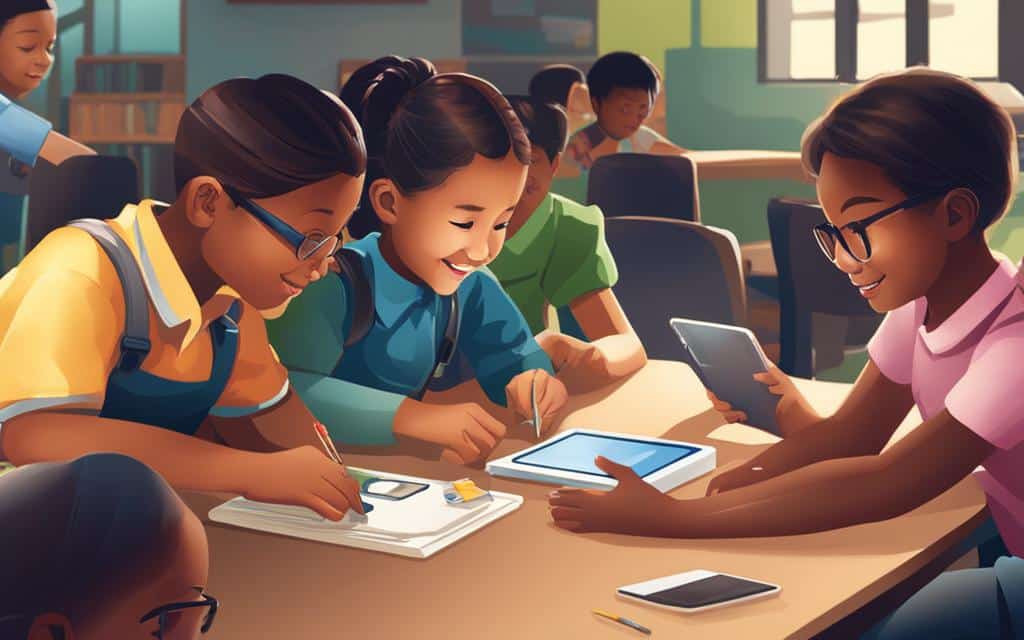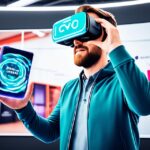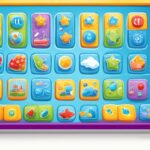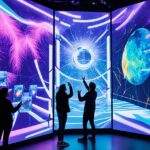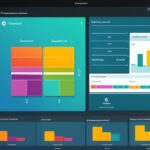Table of Contents
In the rapidly evolving landscape of digital education, interactive design has emerged as a powerful tool for enhancing learning experiences. By incorporating immersive learning strategies, interactive design fosters student engagement and promotes effective knowledge retention. In this article, we will explore the various ways in which interactive design education revolutionizes traditional learning models, creating dynamic and captivating educational experiences that cater to the needs of today’s learners.
One of the key benefits of interactive design education is its ability to promote active student engagement. Rather than passively consuming information, students actively participate and interact with the learning content. This active engagement leads to deeper understanding and increased retention. By immersing themselves in the learning process, students develop critical thinking and problem-solving skills.
Multi-sensory learning is another powerful aspect of interactive design education. This approach harnesses the cognitive theory of multimedia learning, utilizing various senses to create a rich and engaging learning environment. Incorporating visual aids, audio resources, and even virtual reality simulations, multi-sensory learning caters to different learning styles and enhances comprehension.
Experiential learning through interactive design provides hands-on experiences and real-world simulations. By applying theoretical concepts in practical scenarios, students develop practical skills and gain a deeper understanding of the subject matter. Virtual reality (VR) and augmented reality (AR) further enhance experiential learning, creating immersive environments that replicate real-world situations.
Personalized learning is a key feature of interactive design education. By tailoring educational experiences to meet individual learner needs, personalized learning optimizes learning outcomes. Adaptive learning platforms analyze student progress, identify strengths and weaknesses, and deliver customized content and feedback. This learner-centered approach empowers students to take control of their learning journey and set personal goals.
Collaboration and social learning are essential components of interactive design education. By fostering peer interaction and knowledge sharing, collaboration promotes critical thinking and problem-solving skills. Online discussion forums and video conferencing tools enable students to engage in meaningful discussions, share ideas, and learn from each other.
As the digital education landscape continues to evolve, it is vital to harness the benefits of interactive design education. By incorporating immersive learning strategies, educators can create engaging and dynamic learning experiences that captivate students’ attention and promote effective learning outcomes. Join us in exploring the transformative power of interactive design education in our upcoming sections.
Active Engagement in Interactive Learning
Active engagement in interactive learning is a fundamental aspect of modern education. It involves students actively participating and interacting with the learning content rather than being passive recipients of information. This approach promotes deeper understanding and knowledge retention, as students are actively involved in the learning process.
Two pedagogical approaches that foster active engagement are problem-based learning and flipped classrooms. In problem-based learning, students are presented with real-world problems to solve, encouraging them to apply their knowledge and critical thinking skills. This approach nurtures problem-solving abilities and prepares students for real-life scenarios. Flipped classrooms, on the other hand, require students to review and learn content before attending class, allowing for more interactive and engaging discussions and activities during class time.
The theory of constructivism also supports active engagement in learning. According to this theory, learners construct knowledge through their active participation and experiences. By actively engaging with the learning content, students are more likely to make connections, develop a deeper understanding, and retain the information in the long term.
Implementing interactive quizzes or polls during online lectures is an effective strategy to encourage active engagement. These interactive elements not only stimulate student participation but also provide immediate feedback, allowing students to assess their understanding in real-time. Furthermore, incorporating gamified elements, such as educational games or interactive simulations, can make the learning experience more enjoyable and motivate students to actively participate in the learning process.
Active engagement in interactive learning creates a dynamic and stimulating environment that promotes active student involvement, enhances learning outcomes, and ultimately leads to a more enriching educational experience.
Key Strategies for Active Engagement:
- Problem-based learning: Encourages students to solve real-world problems and apply their knowledge.
- Flipped classrooms: Pre-learning content before class to facilitate more interactive discussions and activities.
- Interactive quizzes or polls: Engage students during online lectures and provide real-time feedback.
- Gamified elements: Incorporate educational games or interactive simulations to make learning more enjoyable and motivating.
Active engagement is a crucial component of interactive learning that fosters student participation, deepens understanding, and improves learning outcomes. By implementing problem-based learning, flipped classrooms, interactive quizzes, and gamified elements, educators can create an engaging and impactful learning experience for students.
Multi-Sensory Learning in Interactive Design Education
Multi-sensory learning in interactive design education creates a multi-sensory learning environment by incorporating various senses, such as sight, sound, touch, and even virtual reality (VR) or augmented reality (AR). This approach caters to different learning styles and improves comprehension. The cognitive theory of multimedia learning suggests that presenting information through multiple modalities can enhance learning outcomes.
Strategies for multi-sensory learning include:
- Providing video lectures with visual aids, text, and graphics to engage visual learners and support visual understanding.
- Offering interactive activities that require tactile involvement, such as touchscreens or haptic feedback, to enhance understanding and engagement for kinesthetic learners.
- Creating virtual reality (VR) or augmented reality (AR) experiences that simulate real-world scenarios, allowing learners to actively engage and apply knowledge.
“Multi-sensory learning engages multiple senses, facilitating deeper understanding and knowledge retention.”
Additionally, incorporating audio resources, such as podcasts or recorded interviews, delivers content in an auditory format and caters to different learning preferences.
By employing multi-sensory learning strategies, interactive design education promotes a comprehensive and engaging learning experience that caters to diverse learner needs.
Experiential Learning through Interactive Design
Experiential learning is a pivotal component of interactive design education, enabling students to gain practical skills and apply theoretical concepts in real-world scenarios. By providing hands-on experiences and immersive simulations, learners can actively engage with the content and develop a deeper understanding of the subject matter. In this section, we explore how virtual reality (VR) and augmented reality (AR) technologies enhance experiential learning, as well as the significance of field trips in creating meaningful learning opportunities even in the absence of physical travel.
Utilizing Virtual Reality Simulations for Immersive Experiences
Virtual reality (VR) simulations offer students the opportunity to step into virtual environments and interact with realistic scenarios. By incorporating VR technology into interactive design education, learners can engage in experiential learning that simulates real-life situations. For example, architecture students can walk through detailed 3D models of buildings, enabling them to observe, analyze, and apply architectural principles in a virtual setting. This immersive approach not only enhances retention but also fosters critical thinking, problem-solving skills, and the ability to work under pressure.
Augmented Reality for Real-Time Interactive Learning
Augmented reality (AR) brings digital elements into the real world, creating an interactive learning experience. Through AR applications, students can overlay virtual objects, images, or information on their physical surroundings. For instance, medical students can use AR to visualize and interact with 3D representations of human anatomy, gaining a deeper understanding of the human body. This blended learning approach enhances experiential learning by providing students with real-time, contextual information and the ability to manipulate and explore subjects in a hands-on manner.
Expanding Horizons through Field Trips, Physical or Virtual
Field trips have long been recognized as valuable educational experiences, allowing students to explore environments beyond the classroom. In the context of interactive design education, field trips can provide experiential learning opportunities that bridge the gap between theory and practice. While physical field trips may not always be feasible, especially in remote learning contexts, virtual alternatives have emerged as viable substitutes. Virtual tours enable students to visit museums, historical sites, or natural environments from the comfort of their homes, fostering experiential learning even when physical travel is not possible.
Through experiential learning, interactive design education offers students the chance to engage actively with their studies, develop practical skills, and apply knowledge in real-world scenarios. By leveraging technologies such as virtual reality (VR) and augmented reality (AR), as well as organizing field trips or virtual tours, educators can create immersive and impactful learning experiences that prepare students for the challenges of the real world.
Personalized Learning in Interactive Design Education
Personalized learning in interactive design education is a learner-centered approach that prioritizes tailoring educational experiences to meet individual learner needs. By leveraging adaptive learning platforms, educators can track student progress, identify areas of strengths and weaknesses, and deliver customized content and feedback.
Adaptive learning platforms analyze individual student data, allowing educators to gain valuable insights into student learning patterns and preferences. Based on this analysis, the platforms provide personalized recommendations, ensuring that learners receive content and resources that align with their unique requirements.
One of the key advantages of personalized learning is its alignment with the theory of self-regulated learning. This theory emphasizes learners’ autonomy, self-direction, and goal-setting as essential elements for effective learning. Through personalized learning, students are empowered to take control of their learning journey, set personal learning goals, and monitor their progress.
Strategies for implementing personalized learning in interactive design education include:
- Utilizing adaptive learning platforms that analyze individual student progress and provide personalized recommendations.
- Allowing students to set learning goals and track their progress, giving them autonomy and control over their learning journey.
- Implementing self-assessment tools and reflection activities to foster self-regulated learning.
- Offering a variety of learning resources and materials to cater to diverse learner needs and preferences.
By embracing personalized learning in interactive design education, educators can create a learner-centric environment that promotes engagement, motivation, and meaningful learning experiences. This approach recognizes the unique strengths, interests, and learning styles of individual students, unlocking their full potential.
Comparison of Personalized Learning Approaches
| Approach | Key Features |
|---|---|
| Adaptive Learning Platforms | – Customized content and recommendations based on individual student data – Real-time feedback and progress tracking – Personalized learning paths |
| Self-regulated Learning | – Learners take ownership of their learning – Goal-setting and progress monitoring – Reflection and self-assessment activities |
| Differentiated Instruction | – Tailoring learning activities to individual student needs – Varied instructional approaches and resources – Flexibility and accommodation |
Implementing personalized learning in interactive design education empowers learners to take an active role in their education, enhancing their engagement, motivation, and overall learning outcomes. By harnessing the potential of adaptive learning platforms and adopting a learner-centered approach, educators can create a supportive and transformative learning environment that caters to the needs of every individual learner.
Collaboration and Social Learning in Interactive Design Education
Collaboration and social learning are integral components of interactive design education. According to the social constructivist theory, learning is a social process that takes place through interactions with others. By fostering collaboration and social learning, educators can create dynamic learning environments that enhance student engagement and knowledge construction.
One effective strategy for promoting collaboration is through online discussion forums. These forums provide a platform for students to interact, share ideas, and engage in meaningful discussions. By exchanging perspectives and engaging in constructive dialogue, students can deepen their understanding of the subject matter, challenge their assumptions, and develop critical thinking skills.
In addition to online forums, collaborative projects offer opportunities for students to work together towards a common goal. By collaborating on projects, students can leverage their unique skills and knowledge, learn from each other’s strengths, and develop teamwork and communication skills that are essential in professional settings.
Furthermore, integrating video conferencing tools can facilitate live group discussions, virtual brainstorming sessions, and peer-to-peer feedback on assignments. These technologies enable students to interact in real-time, regardless of their physical location, fostering a sense of connection and community in the online learning environment.
“Collaboration is the key to unlocking the collective wisdom of a group and fostering creativity and innovation.” – Jane Armstrong, Interactive Design Educator
Collaboration and social learning not only enhance students’ cognitive development but also promote the development of essential interpersonal skills. Through collaboration, students learn to value diverse perspectives, practice effective communication, and negotiate and resolve conflicts, preparing them for success in their future careers.
Benefits of Collaboration and Social Learning:
- Enhanced critical thinking skills
- In-depth understanding of subject matter
- Improved communication and interpersonal skills
- Increased motivation and engagement
- Fostering of teamwork and collaboration skills
As interactive design education continues to evolve, collaboration and social learning will remain essential in facilitating meaningful learning experiences and preparing students for the demands of the digital age.
Conclusion
Interactive design education has revolutionized learning experiences, generating increased student engagement and retention. The implementation of active engagement, multi-sensory learning, experiential learning, personalized learning, collaboration, and social learning has played a crucial role in shaping interactive and immersive learning strategies. These approaches have consistently proven to boost motivation, enhance comprehension, and improve knowledge retention.
By integrating interactive elements and leveraging technology, educators have the power to create captivating educational experiences that foster effective learning. Interactive design education is pivotal in transforming traditional learning models and adapting to the ever-evolving landscape of digital education. It provides opportunities for students to become active participants in their education, encouraging them to not only absorb but also apply their understanding in real-life scenarios.
As we continue to embrace the advantages of technology and digital platforms, it is essential to prioritize interactive design education to foster a dynamic and engaging learning environment. By doing so, we empower students to develop critical thinking skills, collaborate with peers, and cultivate a deep understanding of the subject matter. Ultimately, the future of education lies in the hands of interactive design, driving a new era of effective and immersive learning experiences.
FAQ
How does active engagement impact interactive learning?
Active engagement involves students actively participating and interacting with the learning content, promoting deeper understanding and knowledge retention.
What are some strategies for promoting active engagement in interactive learning?
Strategies for active engagement include using interactive quizzes or polls during online lectures to encourage student participation and assess understanding in real-time, and incorporating gamified elements such as educational games or interactive simulations.
How does multi-sensory learning enhance the interactive design education?
Multi-sensory learning incorporates various senses to create a multi-sensory learning environment, catering to different learning styles and improving comprehension.
What is the cognitive theory of multimedia learning?
The cognitive theory of multimedia learning suggests that presenting information through multiple modalities can enhance learning outcomes.
How can VR and AR be used for experiential learning in interactive design education?
Virtual reality (VR) and augmented reality (AR) can create immersive environments for experiential learning, allowing learners to apply theoretical concepts, problem-solve, and develop practical skills.
What are some strategies for implementing experiential learning in interactive design education?
Strategies for experiential learning include utilizing VR or AR simulations to create immersive experiences that allow students to practice skills in realistic scenarios, and organizing field trips or virtual tours where students can explore museums, historical sites, or natural environments.
How does personalized learning benefit interactive design education?
Personalized learning tailors educational experiences to meet individual learner needs, optimizing learning outcomes and aligning with the learner-centered approach and the theory of self-regulated learning.
What are some strategies for implementing personalized learning in interactive design education?
Strategies for personalized learning include using adaptive learning platforms that analyze individual student progress and provide personalized recommendations, and allowing students to set learning goals and track their progress.
How does collaboration and social learning contribute to interactive design education?
Collaboration and social learning foster peer interaction and knowledge sharing, supporting the social constructivist theory that learning is a social process and knowledge is constructed through interactions with others.
What are some strategies for promoting collaboration and social learning in interactive design education?
Strategies for collaboration and social learning include facilitating online discussion forums or collaborative projects where students can interact, share ideas, and learn from each other, as well as integrating video conferencing tools for live group discussions and peer feedback.
How does interactive design education enhance learning experiences?
Interactive design education has transformed learning experiences by increasing engagement and retention through active engagement, multi-sensory learning, experiential learning, personalized learning, collaboration, and social learning.

